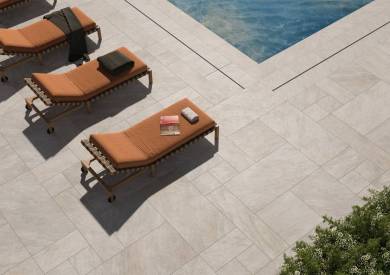Travertine vs Porcelain Pavers: here is how to choose
The timeless appeal of natural stone may be the solution you've been looking for in your outdoor living space, but are you sure that natural travertine is right choice for you? Discover the advantages and limitations of natural stone compared to travertine porcelain pavers.
Travertine is a natural stone and is a particular variety of marble, one of the oldest and most famous, as it was used even in ancient Rome. Travertine is an extremely elegant stone with a timeless appeal and contributes to the exclusivity and refinement of any room, especially homes with an old-fashioned feel and homes where the contrast between modern and classic is to be enhanced. However, this particular natural stone also has a number of limitations in terms of price and maintenance over time. So how can you minimize the complications and achieve the luxurious look of natural travertine?
Travertine porcelain pavers vs travertine pavers
Choosing natural stone or porcelain pavers for your home will provide you with a well-finished, durable and very attractive outdoor space where you can spend your days relaxing. But when it comes to choosing the right finish, you need to carefully consider the significant differences between the two materials.
So, travertine vs porcelain pavers, how to choose?
Porcelain pavers vs travertine: why should I choose porcelain?
In general, the main difference is that porcelain is artificial, while the travertine is found in nature, but travertine porcelain pavers offer the same unique look as natural travertine wherever they are installed, both indoors and outdoors. Travertine porcelain pavers are first and foremost a safe choice for your family and guests, being mildew and mold resistant, anti-slip, totally free of allergens and harmful substances such as PVC, VOC and formaldehyde. The special molecular structure of porcelain pavers prevents the formation and stagnation of bacteria. On the contrary, due to its natural porous conformation, characterized by imperfections, small cracks and holes, travertine is vulnerable to the accumulation of dirt and mold, even when properly maintained. To reduce the proliferation of bacteria, natural travertine requires the use of sealing, resulting in a decrease in aesthetic quality and anti-slip performance.
In the challenge of porcelain pavers vs travertine, one of the main reasons why people choose porcelain is the issue of the cost of porcelain pavers vs travertine. Travertine porcelain pavers guarantee the same luxurious and sophisticated result as natural travertine, but at a much lower price for both raw material and labor. Long-term costs are also cheaper, thanks to the easy cleaning and low maintenance required by porcelain, which is extremely resistant to stains, acids and thermal shock.
Natural travertine, on the other hand, requires more rigorous maintenance and cleaning: being a porous natural stone, it absorbs liquids and stains easily, as well as retaining water which will then create problems during freezing and thawing. Acidic and alkaline substances, stagnant water and extreme heat sources are strictly forbidden on natural travertine.
Travertine porcelain pavers vs travertine pavers: comfort, durability, finishes
If you're looking for an investment that will last a lifetime, travertine porcelain pavers guarantee unrivalled durability, with an average of 75-100 years of life per tile. Travertine porcelain pavers are scratch and stain proof, they never need sealing and will never fade, while travertine can suffer from etching, scratches, staining and passing of time. Porcelain also offers much greater comfort than other materials available on the market, as it maintains a pleasant temperature even when exposed to the hot sun during the summer months: it will no longer be a problem to walk around barefoot by the pool. In terms of aesthetic quality, natural travertine varies according to the type of oxide it is composed of, with generally neutral colors ranging from hazelnut to milk white and yellow. Porcelain tiles, on the other hand, are available in a wide range of colors and allow you to completely express the creativity of your design.
Comparison: travertine porcelain pavers vs travertine pavers
| Travertine Porcelain Pavers | Travertine Pavers | |
|---|---|---|
| Costs | $2 to $10 per square foot (installation $4 to $20 per square foot) | $5 to $30 per square foot (installation $10 to $30 per square foot) |
| Hygiene | Mildew and mold resistant | Highly susceptible to dirt and mold accumulation |
| Safety | Antislip, completely free of allergens and harmful substances | High slipping risk |
| Comfort | Pleasant temperature even when exposed to the scorching summer sun | They overheat when exposed to the sun |
| Sealing | Not required | Necessary |
| Cleaning | Simple, with vinegar and water or specific product for porcelain | Delicate, as natural stone |
| Maintenance | Infrequent, simple, low-cost | Complex and expensive |
| Duration | 75-100 years | Reduced, may deteriorate, stain and crack over time |
| Use | Scratch and stain proof, they never need sealed and will never fade | Can suffer by etching, scratches, staining and passing of time |
| Style | Many varieties of styles, colors and textures. Porcelain can also imitate other materials such as stone and wood | Neutral colors: hazelnut, white, yellow, red |
| Installation | Extremely simple | Delicate and complex, technical staff required |
| Waterproof | Yes | Yes, but prolonged exposure may cause staining |
| Thermal shock resistant | Yes | No |
| Appearance | Elegant and luxurious | Elegant and luxurious |
To conclude the comparison of porcelain pavers vs travertine pavers, we can say that the charm of natural travertine may not be worth its high cost and the many limitations it imposes. Porcelain pavers, on the other hand, are a perfect combination of the elegance of natural stone and high engineering, for an aesthetically impeccable solution and unrivalled performance in terms of cost, maintenance, safety and comfort.










